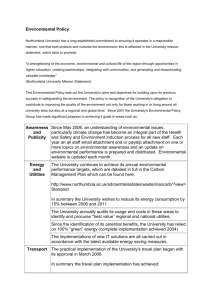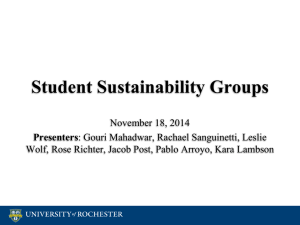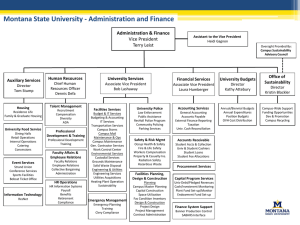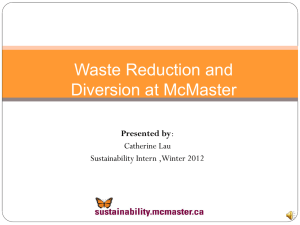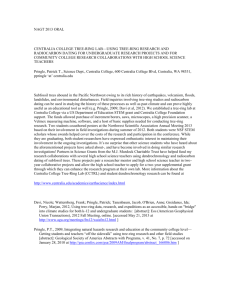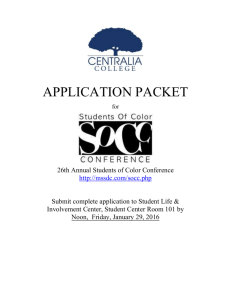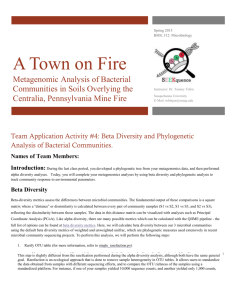MONITORING REPORT
advertisement
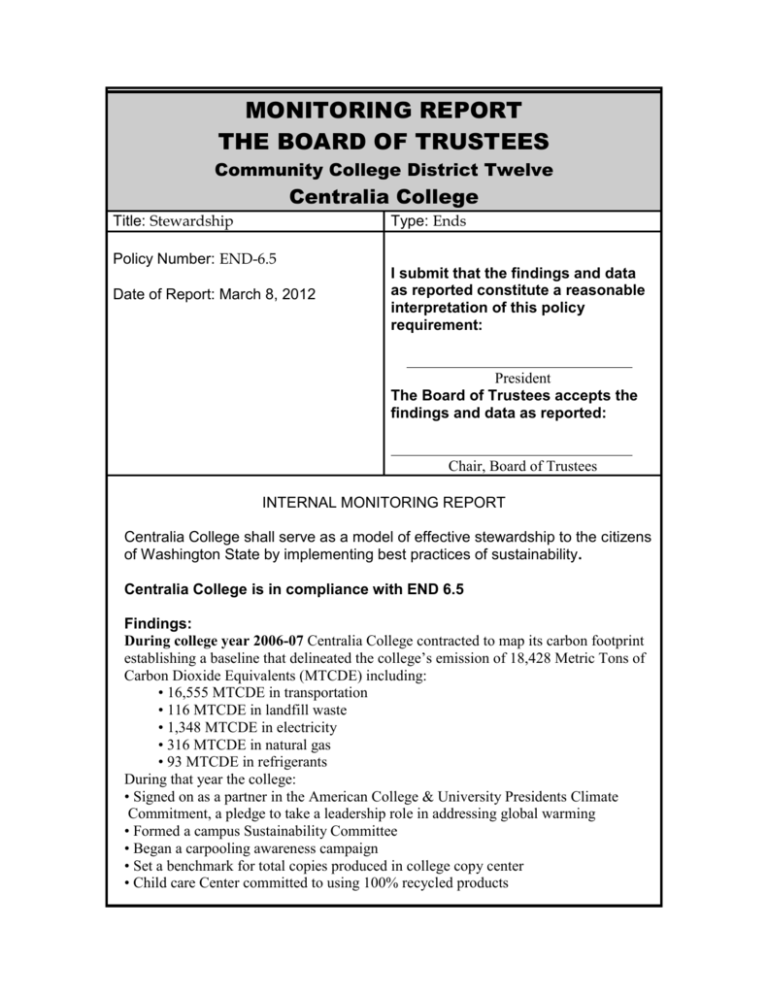
MONITORING REPORT THE BOARD OF TRUSTEES Community College District Twelve Centralia College Title: Stewardship Type: Ends Policy Number: END-6.5 Date of Report: March 8, 2012 I submit that the findings and data as reported constitute a reasonable interpretation of this policy requirement: President The Board of Trustees accepts the findings and data as reported: Chair, Board of Trustees INTERNAL MONITORING REPORT Centralia College shall serve as a model of effective stewardship to the citizens of Washington State by implementing best practices of sustainability. Centralia College is in compliance with END 6.5 Findings: During college year 2006-07 Centralia College contracted to map its carbon footprint establishing a baseline that delineated the college’s emission of 18,428 Metric Tons of Carbon Dioxide Equivalents (MTCDE) including: • 16,555 MTCDE in transportation • 116 MTCDE in landfill waste • 1,348 MTCDE in electricity • 316 MTCDE in natural gas • 93 MTCDE in refrigerants During that year the college: • Signed on as a partner in the American College & University Presidents Climate Commitment, a pledge to take a leadership role in addressing global warming • Formed a campus Sustainability Committee • Began a carpooling awareness campaign • Set a benchmark for total copies produced in college copy center • Child care Center committed to using 100% recycled products In 2007-08 Centralia College: Initiated an aggressive recycling program and placed recycling receptacles throughout the campus Worked with garbage collection service to sort refuse into garbage and recyclables Re-energized the student carpooling campaign, which includes a continually updated commuter and online carpool map Expanded its online class offerings, which decreases or eliminates the number of days students need to come to campus Increased awareness of the free bus passes for students and/or faculty Opened additional car pool parking slots and installed outlets to charge electric cars Reduced the number of pages in the printed quarterly class schedule Took part in a Focus the Nation sustainability awareness campaign Created stormwater ponds Added bike racks to campus Welding students reused (and continue to do so) railroad rails for class projects Updated energy management control systems Installed Low NOx boilers and water heaters In 2008-09 Centralia College: Reduced copy center copies by one million Attained LEED Silver status for the New Science Center Applied for Leadership in Engineering, Environment and Design (LEED) Gold status for the New Science Center Incorporated appropriate low-water type plants around Science Center and Health and Wellness Center Installed recharging station parking spaces for electric vehicles Increased the parking spaces for carpooling commuters Produced a paperless college catalog Several faculty members going to online-only delivery of class information Increase in the number of faculty members who reduce the amount of paper used Gradual conversion to Angel for educational support, reducing the amount of paper Eliminated or greatly restricted out of state travel Installed a hydration (filtered water dispenser) station Placed energy efficient Black Night lights on campus blue&gold, the student newspaper, converted to online-only publication Initiated a policy to purchase only energy star certified product where practical and financially possible Hosted the Go Green Expo sustainability awareness event Efficient lighting installed throughout Health and Wellness Center Secured through a grant an electric vehicle for use by campus personnel Began efforts to convert printed publications to online Began a “turn off the light” campaign for last person leaving a room The correspondence program transitioned from paper to digital delivery, which saved about 15,000 printed sheets of paper per quarter In 2009-10 Continued to move toward electronic printing of publications Attained LEED Gold Standard for the Science Center The foundation became more aggressive with collecting e-mail addresses and continuing the efforts to deliver publications electronically Added recycling stations around the campus Replaced older heat pumps in Tech Bldg with energy-efficient units Continued the switch to eco-friendly (green) chemicals by maintenance staff Recycled consumable supplies (such as hanging files and file folders) are purchased and used whenever available (CCE) College moves to using 100 percent recycled paper for printing and photocopying CCEast has attempted to plan class times around the LEWIS Mountain Highway Transit schedule to encourage use of public transportation Coffee cups, plates, bowls and silverware are available for student use (to avoid using consumable paper products) Energy saving refrigerator was purchased by the Centralia College East Organization of Students Centralia College East sponsored Lyceum lectures on the topics “Measuring Your Carbon Footprint” and “Talking Trash: Recycling in Lewis County” Native vegetation is used on the grounds to keep watering and maintenance to a minimum In 2010-11 Through the sustainability committee, held a tree-planting event to serve as a carbon emission offset Set up collection stations for aerosol can recycling Significantly reduced watering of lawns/gardens during summer Reduced paper usage by requiring student use of email accounts Continue to replace inefficient lights with compact fluorescent and LED lighting Completed state mandated report on carbon based emissions, natural gas consumption, vehicle fleet energy consumption, electricity usage, and emissions from employee business travel Cafeteria begins using recycled and/or biodegradable supplies where possible Scholarship application forms are filled out and processed electronically Thermostats are adjusted each quarter to coincide with when the classrooms are being used (CCE) Thermostats are turned down in the evenings and weekends (CCE) The campus is closed on Fridays during summer quarter which decreases overall energy needs (CCE) Classrooms are kept shut down and thermostats adjusted during quarter breaks (CCE) Scratch paper baskets in classrooms utilize recycled/used paper (CCE) Copies of one-sided forms (such as FAX cover sheets) are made on used paper Consumable office supplies are used multiple times, including file folders and binders In 2011-12: Implemented a Print Management System that eliminated the free and unrestricted use of student-accessible printers resulting in a library paper use reduction of about 90 percent Continued efforts increase recycling through awareness programs by students Added hydration stations in Washington Hall and the New Science Center Reduce the number of sheets of paper consumed by the college’s reprographics center Changed to more efficient heat pumps in Student Center Bldg. that also accommodate environmentally friendly refrigerants Installed LED lighting in cafeteria PTK conducted an energy audit of the Student Center Bldg. and provided low-cost or no-cost recommendations to improve efficiency (switching to LED lighting is an example), as well as higher cost strategies Disposable item used in the cafeteria now are bio-degradable and compostable products Actions items for 2011-12: Replicate the initial Carbon Footprint report with updated data Work toward increasing recycling efforts Evaluate the necessity of increasing the carpool and/or electric car parking space Host a 2010 edition of the Go Green Expo (increase community awareness of regional efforts toward sustainability Reduce the number of sheets of paper consumed by the college’s reprographics center Initiate carbon offsets by tree plantings Generate electricity through the Energy Technology program to sell back into the regional electrical grid Response: State Department of Ecology mandated reporting information, which replaces the Carbon Footprint report–completed Recycling efforts continue The college has added carpool slots and free parking decals are issued to registered carpooler Go Green Expo was not held; PTK redirected its focus to safety issues On-campus use of paper in the reprographics center decreased while the number of impressions increased by about 4.13% (perhaps due to increased enrollments) Tree planting event held The effort to generate and sell electricity is on hold pending further development of Knoll project Action items for 2012-13 Continue to work toward Dept. of Ecology goal of reducing emissions by 15 percent from 2005 levels by 2020 Assist and support student efforts toward Sustainability week activities Purchase and put in place new edition hand dryers that will reduce paper consumption Continue to explore means of raising awareness of the need to recycle and continue the college’s path to support its commitment to sustainability Determine feasibility of using college-generated electricity for lighting in the Knoll Continue efforts to replace older fluorescent lights with LED lighting, where feasible Hold a second tree-planting event Research solar parking lot lights Continue to encourage staff to attend meetings via ITV or Elluminate or other means instead of traveling Definitions: Carbon Footprint: the total set of greenhouse gases (GHG) emissions caused by an organization, event or product. For simplicity of reporting, it is often expressed in terms of the amount of carbon dioxide, or its equivalent of other GHGs, emitted. Climate Action Plan: a written plan of systematic actions that will lead to higher levels of sustainability and, eventually, carbon neutrality. Greenhouse Gases: are gases in an atmosphere that absorb and emit radiation; main gases are water vapor, carbon dioxide, methane, nitrous oxide, and ozone. Carbon Offsets: financial expenditures or events or actions aimed at a reduction in greenhouse gas emissions. Carbon offsets are measured in metric tons of carbon dioxide-equivalent (MTCDE-e) and may represent six primary categories of greenhouse gases. One carbon offset represents the reduction of one metric ton of carbon dioxide or its equivalent in other greenhouse gases. LEED: Leadership in Energy and Environmental Design, an internationally recognized green building certification system, providing third-party verification that a building or community was designed and built using strategies aimed at improving performance across all the metrics that matter most: energy savings, water efficiency, CO2 emissions reduction, improved indoor environmental quality, and stewardship of resources and sensitivity to their impacts.




